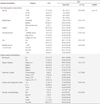Abstract
Purpose
This study was conducted to identify the impact of fatigue, pain, anxiety and depression on the quality of life (QOL) among breast cancer patients.
Methods
This study was conducted from July 12th to July 20th, 2010. One hundred and fifty breast cancer patients were recruited from D city in Korea. The instruments used in this study were the fatigue, pain, anxiety, depression and the quality of life scales for patients with breast cancer. Data were analyzed using descriptive statistics, t-test, ANOVA, Pearson correlation coefficients and multiple regression with the SPSS/WIN 12.0 program.
Figures and Tables
References
1. Brem S, Kumar NB. Management of treatment-related symptoms in patients with breast cancer: Current strategies and future directions. Clin J Oncol Nurs. 2011. 15:63–71.
3. Kim SH, Lee R, Lee KS. Symtom clusters in patients with breast cancer. J Korean Acad Adult Nurs. 2009. 21:705–717.
4. Byar KL, Berger AM, Bakken SL, Cetak MA. Impact of adjuvant breast cancer chemotherapy on fatigue, other symptoms, and quality of life. Oncol Nurs Forum. 2006. 33:E18–E26.
5. Dodd MJ, Cho MH, Cooper BA, Miaskowski C. The effect of symptom cluster on functional status and quality of life in women with breast cancer. Eur J Oncol Nurs. 2010. 14:101–110.

6. Miaskowski C, Cooper BA, Paul SM, Dodd M, Lee K, Aouizerat BE, et al. Subgroups of patients with cancer with different symptom experiences and quality-of-life outcomes: A cluster analysis. Oncol Nurs Forum. 2006. 33:E79–E89.

7. So WK, Marsh G, Ling WM, Leung FY, Lo JC, Yeung M, et al. The symptom cluster of fatigue, pain, anxiety, and depression and the effect on the quality of life of women receiving treatment for breast cancer: a multicenter study. Oncol Nurs Forum. 2009. 36:E205–E214.

8. Suh YO. Predictors of quality of life in women with breast cancer. J Korean Acad Nurs. 2007. 37:459–466.

9. Kim YS, Tae YS. The influencing factors on quality of life among breast cancer survivors. J Korean Oncol Nurs. 2011. 11:221–228.

10. Park JH, Jun EY, Kang MY, Joung YS, Kim GS. Symptom experience and quality of life in breast cancer survivors. J Korean Acad Nurs. 2009. 39:613–621.

11. Pud D, Ben Ami S, Cooper BA, Aouizerat BE, Cohen D, Radiano R, et al. The symptom experience of oncology outpatients has a different impact on quality-of life outcomes. J Pain Symptom Manage. 2008. 35:162–170.

12. Bower JE, Ganz PA, Desmond KA, Bernaards C, Rowland JH, Meyerowitz BE, et al. Fatigue in long-term breast carcinoma survivors: a longitudinal investigation. Cancer. 2006. 106:751–758.
13. Cavalli Kluthcovsky AC, Urbanetz AA, de Carvalho DS, Pereira Maluf EM, Schlickmann Sylvestre GC, Bonatto Hatschbach SB. Fatigue after treatment in breast cancer survivors: prevalence, determinants and impact on health-related quality of life. Support Care Cancer. 2011. 13:1293–1297.

14. Stevens PE, Dibble SL, Miaskowski C. Prevalence, characteristics, and impact of postmastectomy pain syndrome: an investigation of women's experience. Pain. 1995. 61:61–68.

15. Chong MS, Bajwa ZH. Diagnosis and treatment of neuropathic pain. J Pain Symptom Manage. 2003. 25:S4–S11.

16. Jung BF, Hermann D, Griggs J, Oaklander LA, Dworkin RH. Neuropathic pain associated with non-surgical treatment of breast cancer. Pain. 2005. 118:10–14.

17. Fann JR, Thomas-Rich AM, Katon WJ, Cowley D, Pepping M, Mcgregor BA, et al. Major depression after breast cancer: a review of epidemiology and treatment. Gen Hosp Psychiatry. 2008. 30:112–126.

18. Reyes-Gibby CC, Anderson KO, Morrow PK, Shete S, Hassan S. Depressive symptoms and health-related quality of life in breast survivors. J Womens Health. 2012. 21:1–8.
19. van den Beuken-van Everdingen MH, de Rijke JM, Kessels AG, Schouten HC, van Kleef M, Pantijin J. Quality of life and non-pain symptoms in patients with cancer. J pain Symptom Manage. 2009. 38:216–233.
20. Burgess C, Cornelius V, Love S, Graham J, Richards M, Ramirez A. Depression and anxiety in women with early breast cancer: Five year observational cohort study. BMJ. 2005. 330:702–705.

21. FACIT-Fatigue scale-Korean version. Functional Assessment of Chronic Illness Therapy. accessed on 1 June 2010. Availble at://www.facit.org/FACITOrg/Questionnaires.
22. Kim JT, Shin DK. A study based on the standardization of the STAI for Korea. New Med J. 1978. 21:69–75.
23. Chon KK, Lee MK. Preliminary development of Korean version of CES-D. Korean J Clini Psychol. 1992. 11:65–76.
24. Functional assessment of cancer therapy-breast cancer version 4-Korean version. Functional Assessment of Chronic Illness Therapy. accessed on 1 June 2010. Availble at //www.facit.org/FACITOrg/Questionnaires.
25. Kim GD, Kim KH. Symptom cluster and quality of life with breast cancer undergoing chemotherapy. Korean J Adult Nurs. 2011. 23:434–445.
26. Byun HS, Kim GD, Chung BY, Kim KH. Fatigue and quality of life of Korean cancer inpatients. Korean J Hosp Palliat Care. 2010. 13:98–108.

27. Stevens PE, Dibble SL, Miaskowski C. Prevalence, characteristics, and impact of postmastectomy pain syndrome: an investigation of women's experience. Pain. 1995. 61:61–68.

28. Chong SM, Bajwa ZH. Diagnosis and treatment of neuropathic pain. J Pain Symptom Manage. 2003. 25(5):S4–S11.





 PDF
PDF ePub
ePub Citation
Citation Print
Print






 XML Download
XML Download